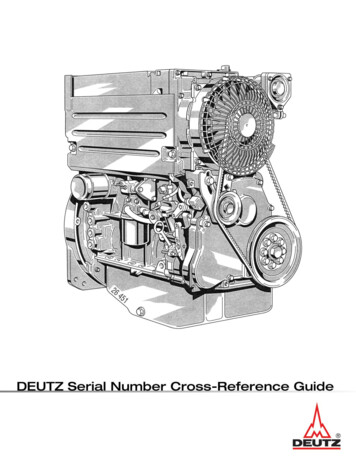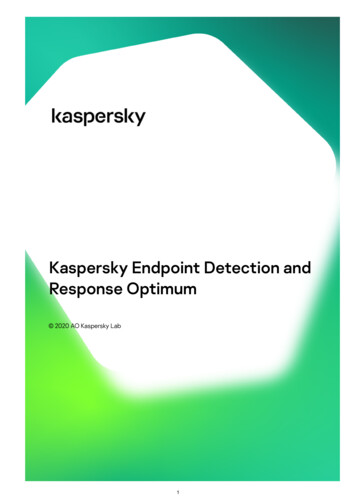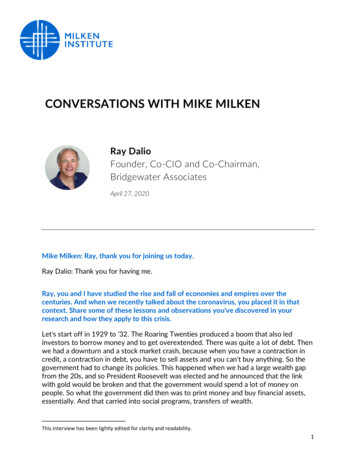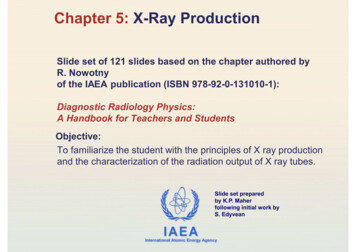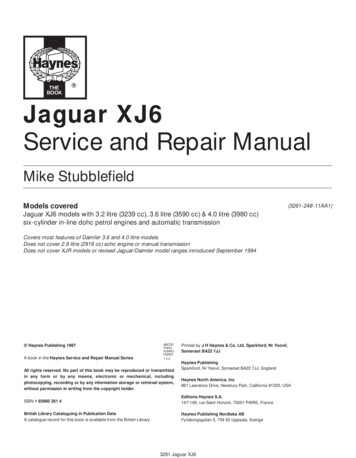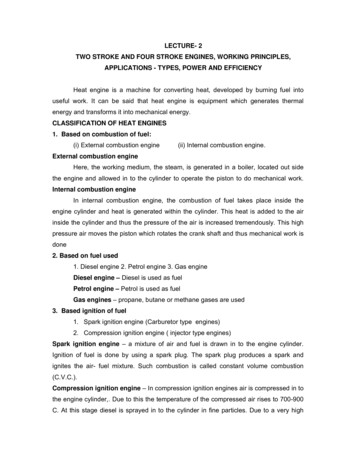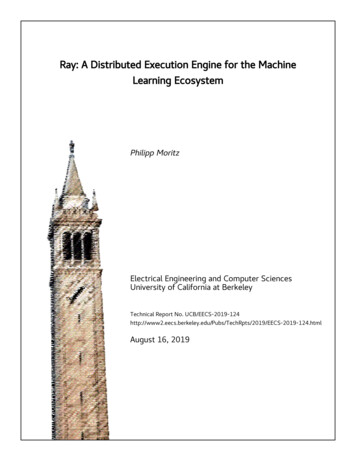
Transcription
Ray: A Distributed Execution Engine for the MachineLearning EcosystemPhilipp MoritzElectrical Engineering and Computer SciencesUniversity of California at BerkeleyTechnical Report No. s/TechRpts/2019/EECS-2019-124.htmlAugust 16, 2019
Copyright 2019, by the author(s).All rights reserved.Permission to make digital or hard copies of all or part of this work forpersonal or classroom use is granted without fee provided that copies arenot made or distributed for profit or commercial advantage and that copiesbear this notice and the full citation on the first page. To copy otherwise, torepublish, to post on servers or to redistribute to lists, requires prior specificpermission.
Ray: A Distributed Execution Engine for the Machine Learning EcosystembyPhilipp C MoritzA dissertation submitted in partial satisfaction of therequirements for the degree ofDoctor of PhilosophyinComputer Sciencein theGraduate Divisionof theUniversity of California, BerkeleyCommittee in charge:Professor Michael I. Jordan, ChairProfessor Ion StoicaProfessor Ken GoldbergSummer 2019
Ray: A Distributed Execution Engine for the Machine Learning EcosystemCopyright 2019byPhilipp C Moritz
1AbstractRay: A Distributed Execution Engine for the Machine Learning EcosystembyPhilipp C MoritzDoctor of Philosophy in Computer ScienceUniversity of California, BerkeleyProfessor Michael I. Jordan, ChairIn recent years, growing data volumes and more sophisticated computational procedureshave greatly increased the demand for computational power. Machine learning and artificialintelligence applications, for example, are notorious for their computational requirements.At the same time, Moores law is ending and processor speeds are stalling. As a result,distributed computing has become ubiquitous. While the cloud makes distributed hardwareinfrastructure widely accessible and therefore offers the potential of horizontal scale, developing these distributed algorithms and applications remains surprisingly hard. This is due tothe inherent complexity of concurrent algorithms, the engineering challenges that arise whencommunicating between many machines, the requirements like fault tolerance and stragglermitigation that arise at large scale and the lack of a general-purpose distributed executionengine that can support a wide variety of applications.In this thesis, we study the requirements for a general-purpose distributed computation model and present a solution that is easy to use yet expressive and resilient to faults.At its core our model takes familiar concepts from serial programming, namely functionsand classes, and generalizes them to the distributed world, therefore unifying stateless andstateful distributed computation. This model not only supports many machine learningworkloads like training or serving, but is also a good fit for cross-cutting machine learningapplications like reinforcement learning and data processing applications like streaming orgraph processing. We implement this computational model as an open-source system calledRay, which matches or exceeds the performance of specialized systems in many applicationdomains, while also offering horizontally scalability and strong fault tolerance properties.
iTo my parents Hugo and Birgit,and my sisters Christine and Sophie,for their constant love and support!
iiContentsContentsiiList of FiguresivList of Tablesviii1 Introduction2 The2.12.22.32.41Distributed Computation LandscapeThe Bulk Synchronous Parallel Model . . .The Task Parallel Model . . . . . . . . . .The Communicating Processes Model . . .The Distributed Shared Memory Model . .4568103 Motivation: Training Deep Networks in Spark3.1 Introduction . . . . . . . . . . . . . . . . . . . .3.2 Implementation . . . . . . . . . . . . . . . . . .3.3 Experiments . . . . . . . . . . . . . . . . . . . .3.4 Related Work . . . . . . . . . . . . . . . . . . .3.5 Discussion . . . . . . . . . . . . . . . . . . . . .111113151920.262829313232.33353942474 The4.14.24.34.44.5System RequirementsMotivating Example . .Proposed Solution . . . .Feasibility . . . . . . . .Related Work . . . . . .Conclusion . . . . . . . .5 The5.15.25.35.4Design and Implementation of RayMotivation and Requirements . . . . . .Programming and Computation Model .Architecture . . . . . . . . . . . . . . . .Evaluation . . . . . . . . . . . . . . . . .
iii5.55.65.76 Use6.16.26.36.46.56.66.76.8Related Work . . . . . . . . . . . . . . . . . . . . . . . . . . . . . . . . . . .Discussion and Experiences . . . . . . . . . . . . . . . . . . . . . . . . . . .Conclusion . . . . . . . . . . . . . . . . . . . . . . . . . . . . . . . . . . . . .565860Case: Large Scale OptimizationIntroduction . . . . . . . . . . . . . .The Algorithm . . . . . . . . . . . .Preliminaries . . . . . . . . . . . . .Convergence Analysis . . . . . . . . .Related Work . . . . . . . . . . . . .Experimental Results . . . . . . . . .Proofs of Preliminaries . . . . . . . .Discussion . . . . . . . . . . . . . . .616163646668697174.7 Conclusion76Bibliography79
ivList of Figures2.12.22.3Building an inverted index with MapReduce . . . . . . . . . . . . . . . . . . . . . .Neural network task graph, source https://www.tensorflow.org/guide/graphs . .A chatroom implementation in the actor framework . . . . . . . . . . . . . . . . . .6793.13.23.3This figure depicts the SparkNet architecture. . . . . . . . . . . . . . . . . . . .Computational models for different parallelization schemes. . . . . . . . . . . . .This figure shows the speedup τ Ma (b, τ, K)/Na (b) given by SparkNet’s parallelization scheme relative to training on a single machine to obtain an accuracyof a 20%. Each grid square corresponds to a different choice of K and τ . Weshow the speedup in the zero communication overhead setting. This experimentuses a modified version of AlexNet on a subset of ImageNet (100 classes eachwith approximately 1000 images). Note that these numbers are dataset specific.Nevertheless, the trends they capture are of interest. . . . . . . . . . . . . . . .This figure shows the speedups obtained by the naive parallelization scheme andby SparkNet as a function of the cluster’s communication overhead (normalizedso that C(b) 1). We consider K 5. The data for this plot applies totraining a modified version of AlexNet on a subset of ImageNet (approximately1000 images for each of the first 100 classes). The speedup obtained by thenaive parallelization scheme is C(b)/(C(b)/K S). The speedup obtained bySparkNet is Na (b)C(b)/[(τ C(b) S)Ma (b, K, τ )] for a specific value of τ . Thenumerator is the time required by serial SGD to achieve an accuracy of a, andthe denominator is the time required by SparkNet to achieve the same accuracy(see Equation 3.1 and Equation 3.2). For the optimal value of τ , the speedup ismaxτ Na (b)C(b)/[(τ C(b) S)Ma (b, K, τ )]. To plot the SparkNet speedup curve,we maximize over the set of values τ {1, 2, 5, 10, 25, 100, 500, 1000, 2500} anduse the values Ma (b, K, τ ) and Na (b) from the experiments in the fifth row ofFigure 3.3. In our experiments, we have S 20s and C(b) 2s. . . . . . . . .This figure shows the performance of SparkNet on a 3-node, 5-node, and 10-nodecluster, where each node has 1 GPU. In these experiments, we use τ 50. Thebaseline was obtained by running Caffe on a single GPU with no communication.The experiments are performed on ImageNet using AlexNet. . . . . . . . . . .13223.43.5232425
v3.63.74.15.15.25.35.45.55.65.7This figure shows the performance of SparkNet on a 3-node cluster and on a 6node cluster, where each node has 4 GPUs. In these experiments, we use τ 50.The baseline uses Caffe on a single node with 4 GPUs and no communicationoverhead. The experiments are performed on ImageNet using GoogLeNet. . . .This figure shows the dependence of the parallelization scheme described in Section 3.2 on τ . Each experiment was run with K 5 workers. This figure showsthat good performance can be achieved without collecting and broadcasting themodel after every SGD update. . . . . . . . . . . . . . . . . . . . . . . . . . . .25(a) Traditional ML pipeline (off-line training). (b) Example reinforcement learningpipeline: the system continously interacts with an environment to learn a policy, i.e.,a mapping between observations and actions. . . . . . . . . . . . . . . . . . . .27Example of an RL system. . . . . . . . . . . . . . . . . . . . . . . . . . . . . . . .Typical RL pseudocode for learning a policy. . . . . . . . . . . . . . . . . . . . . .Python code implementing the example in Figure 5.2 in Ray. Note that @ray.remote indicates remote functions and actors. Invocations of remote functions and actor methodsreturn futures, which can be passed to subsequent remote functions or actor methodsto encode task dependencies. Each actor has an environment object self.env sharedbetween all of its methods. . . . . . . . . . . . . . . . . . . . . . . . . . . . . . .The task graph corresponding to an invocation of train policy.remote() in Figure 5.3.Remote function calls and the actor method calls correspond to tasks in the task graph.The figure shows two actors. The method invocations for each actor (the tasks labeledA1i and A2i ) have stateful edges between them indicating that they share the mutableactor state. There are control edges from train policy to the tasks that it invokes. Totrain multiple policies in parallel, we could call train policy.remote() multiple times.Ray’s architecture consists of two parts: an application layer and a system layer. Theapplication layer implements the API and the computation model described in Section 5.2, the system layer implements task scheduling and data management to satisfythe performance and fault-tolerance requirements. . . . . . . . . . . . . . . . . . . .Bottom-up distributed scheduler. Tasks are submitted bottom-up, from drivers andworkers to a local scheduler and forwarded to the global scheduler only if needed (Section 5.3). The thickness of each arrow is proportional to its request rate. . . . . . . .An end-to-end example that adds a and b and returns c. Solid lines are data planeoperations and dotted lines are control plane operations. (a) The function add() isregistered with the GCS by node 1 (N 1), invoked on N 1, and executed on N 2. (b) N 1gets add()’s result using ray.get(). The Object Table entry for c is created in step 4and updated in step 6 after c is copied to N 1. . . . . . . . . . . . . . . . . . . . . .2536364041424446
vi5.85.95.105.115.125.135.146.1(a) Tasks leverage locality-aware placement. 1000 tasks with a random object dependency are scheduled onto one of two nodes. With locality-aware policy, task latencyremains independent of the size of task inputs instead of growing by 1-2 orders of magnitude. (b) Near-linear scalability leveraging the GCS and bottom-up distributed scheduler. Ray reaches 1 million tasks per second throughput with 60 nodes. x {70, 80, 90}omitted due to cost. . . . . . . . . . . . . . . . . . . . . . . . . . . . . . . . .Object store write throughput and IOPS. From a single client, throughput exceeds15GB/s (red) for large objects and 18K IOPS (cyan) for small objects on a 16 coreinstance (m4.4xlarge). It uses 8 threads to copy objects larger than 0.5MB and 1thread for small objects. Bar plots report throughput with 1, 2, 4, 8, 16 threads.Results are averaged over 5 runs. . . . . . . . . . . . . . . . . . . . . . . . . .Ray GCS fault tolerance and flushing. . . . . . . . . . . . . . . . . . . . . . . . .Ray fault-tolerance. (a) Ray reconstructs lost task dependencies as nodes are removed(dotted line), and recovers to original throughput when nodes are added back. Eachtask is 100ms and depends on an object generated by a previously submitted task. (b)Actors are reconstructed from their last checkpoint. At t 200s, we kill 2 of the 10nodes, causing 400 of the 2000 actors in the cluster to be recovered on the remainingnodes (t 200–270s). . . . . . . . . . . . . . . . . . . . . . . . . . . . . . . .(a) Mean execution time of allreduce on 16 m4.16xl nodes. Each worker runs on adistinct node. Ray* restricts Ray to 1 thread for sending and 1 thread for receiving.(b) Ray’s low-latency scheduling is critical for allreduce. . . . . . . . . . . . . .Images per second reached when distributing the training of a ResNet-101 TensorFlowmodel (from the official TF benchmark). All experiments were run on p3.16xl instancesconnected by 25Gbps Ethernet, and workers allocated 4 GPUs per node as done inHorovod [116]. We note some measurement deviations from previously reported, likelydue to hardware differences and recent TensorFlow performance improvements. Weused OpenMPI 3.0, TF 1.8, and NCCL2 for all runs. . . . . . . . . . . . . . . .Time to reach a score of 6000 in the Humanoid-v1 task [21]. (a) The Ray ES implementation scales well to 8192 cores and achieves a median time of 3.7 minutes, over twice asfast as the best published result. The special-purpose system failed to run beyond 1024cores. ES is faster than PPO on this benchmark, but shows greater runtime variance.(b) The Ray PPO implementation outperforms a specialized MPI implementation [97]with fewer GPUs, at a fraction of the cost. The MPI implementation required 1 GPUfor every 8 CPUs, whereas the Ray version required at most 8 GPUs (and never morethan 1 GPU per 8 CPUs). . . . . . . . . . . . . . . . . . . . . . . . . . . . . .The left figure plots the log of the optimization error as a function of the number of passes through the data for SLBFGS, SVRG, SQN, and SGD for a ridgeregression problem (Millionsong). The middle figure does the same for a supportvector machine (RCV1). The right plot shows the training loss as a functionof the number of passes through the data for the same algorithms for a matrixcompletion problem (Netflix). . . . . . . . . . . . . . . . . . . . . . . . . . . . .4849505152535568
vii6.26.3These figures show the log of the optimization error for SLBFGS, SVRG, SQN,and SGD on a ridge regression problem (millionsong) for a wide range of step sizes. 69These figures show the log of the optimization error for SLBFGS, SVRG, SQN,and SGD on a support vector machine (RCV1) for a wide range of step sizes. . . 70
viiiList of Tables2.1The spectrum of distributed computing . . . . . . . . . . . . . . . . . . . . . . .45.15.25.3Ray API . . . . . . . . . . . . . . . . . . . . . . . . . . . . . . . . . . . . . . . .Tasks vs. actors tradeoffs. . . . . . . . . . . . . . . . . . . . . . . . . . . . . . . .38385.4Throughput comparisons for Clipper [30], a dedicated serving system, and Ray for twoembedded serving workloads. We use a residual network and a small fully connectednetwork, taking 10ms and 5ms to evaluate, respectively. The server is queried by clientsthat each send states of size 4KB and 100KB respectively in batches of 64. . . . . . .Timesteps per second for the Pendulum-v0 simulator in OpenAI Gym [21]. Ray allowsfor better utilization when running heterogeneous simulations at scale. . . . . . . . .5454
ixAcknowledgmentsI am deeply grateful to the many people who were part of my PhD journey. They helped meto grow professionally and as a person, and have made my time at Berkeley unforgettable.Without them this thesis would not have been possible. I would like to thank:My advisor Michael Jordan for bringing me to Berkeley, for inspiring and encouragingme throughout my PhD, for bringing together such an exceptional and supportive group ofpeers and for motivating all of us with his kindness, enthusiasm and positivity.My advisor Ion Stoica for mentoring me. His obsession with real-world impact andresearch that truly matters is unparalleled. He taught me many valuable lessons aboutresearch, systems design, planning, products and execution and truly expanded my horizon.Robert Nishihara, who has influenced my PhD journey like nobody else. His ability toconfidently bust through any obstacle that might arise has greatly inspired me and helpedme to not only see, but also reach the light at the end of the tunnel.John Schulman with whom I collaborated closely at the beginning of my PhD. We havehad many great conversations over the years and he has been a source of inspiration andideas ever since!Cathy Wu for countless discussions about research and life, her kindness and all theunforgettable memories we forged.I would like to thank all the members of the Ray team, including Stephanie Wang, EricLiang, Richard Liaw, Devin Petersohn, Alexey Tumanov, Peter Schafhalter, Si-Yuan Zhuang,Zongheng Yang, William Paul, Melih Elibol, Simon Mo, William Ma, Alana Marzoev, andRomil Bhardwaj. Thanks for a great collaboration. I have learned a lot from you!I would like to thank my friends and colleagues from the research groups I have beenpart of. SAIL has been incredible. It is hard to describe the amount of knowledge and ideasthat were transferred at our weekly research meetings, and the positivity and support fromall of you, including Stefanie Jegelka, Ashia Wilson, Horia Mania, Mitchell Stern, TamaraBroderick, Ahmed El Alaoui, Esther Rolf, Chi Jin, Max Rabinovich, Nilesh Tripuraneni,Karl Krauth, Ryan Giordano, John Duchi, and Nick Boyd. The AMPLab, RISELab andBAIR have been a great community of friends and collaborators. Berkeley is unique for itscollaborative research style, and the lab culture plays a major role in that.I would like to thank my quals and thesis committee, Ken Goldberg, Joey Gonzalez andFernando Perez for their insights, advice and support over the years!My friend Fanny Yang for constant friendship and support, the many races and memories.You truly made a difference!Many friends who made this journey unforgettable, including Fan Wei, Olivia Anguli,Richard Shin, Frank Li, Atsuya Kumano, Jordan Sullivan, Vinay Ramasesh, Jacob Steinhardt, Ludwig Schmidt, Reinhard Heckel, Jacob Andreas, Alyssa Morrow, Jeff Mahler,Mehrdad Niknami, Smitha Milli, Marc Khoury and Sasha Targ.My home for the last five years, a big house on the south side of Berkeley, called “LittleMountain”. Rishi Gupta for founding it and everybody living there for the great time wehad together.
xI would like to thank the Nishihara family for so kindly inviting and integrating me intomany family gatherings and making me feel at home in the Bay area.This thesis is dedicated to my family. My parents Hugo and Birgit, who created theright environment for me to thrive. Their unconditional love and support have made allthe difference. My sisters Christine and Sophie for being awesome life companions, for theirsupport and guidance over the year.
1Chapter 1IntroductionWe are living in a remarkable time. In the span of a single human lifetime, we have seen thebirth of machines that can process data, automatically perform tasks and make decisions.They have grown to have substantial real-world impact. If you are looking for any piece ofinformation, there is a good chance that Google can find it for you. If you want to buy aproduct or get recommendations on what to buy, there is a large number of services on theinternet that will help you to spend money, including Amazon. If you want to quickly getfrom A to B without having to worry about the details, ride sharing services like Uber or Lyftare the way to go. And not only our personal lives but also society crucially depends on ourdigital infrastructure. Science, education, our health care system and public administrationas well as corporations would be unable to operate and coordinate the work of so many peoplewithout the help of computers. Computers are capable of running such diverse workloads ascrunching numbers for scientific simulations, running complex queries on relational data tohelp operate large corporations or connecting people around the globe, and they are slowlystarting to perform some of the complex cognitive tasks that only humans were capable ofin the past. And fast forward another human lifetime, we will look back and realize thattodays capabilities pale in comparison to what will be possible then.Much of the computation is happening in the cloud, a large collection of servers thatcan be rented from providers like Amazon, Microsoft or Google. We typically use “edge”devices like smartphones or laptops to interface with the digital world, but in most casesthe actual logic is implemented in the cloud. You become painfully aware of this if yourphone gets disconnected from the internet and many important applications stop working.There are good reasons to shift much of the processing into the cloud: Moore’s law is ending,therefore single-core performance is not getting much faster, which means compute heavyapplication logic needs a large number of cores, which are typically only available on a cluster.Computing in the cloud also improves resource usage as processors can be shared betweenusers and applications. One of the most important reasons why companies typically preferrunning application logic in the cloud rather than the edge is control: They can determinethe compute environment, have full access to the data and can secure private data andalgorithms more easily.
CHAPTER 1. INTRODUCTION2Given this trend, it is quite surprising that distributed programming in the cloud is stillvery hard. Distributed systems is one of the more complex topics in computer science andwhile there is a large amount of research in this field, there is less work on making it easierfor non-experts to build distributed software. If they want flexible systems, programmerstypically have to build distributed applications from low-level primitives like remote procedure call layers, distributed key-value stores and cluster managers, which requires a lotof expertise, duplicates work between different distributed systems and makes the task ofdebugging a distributed application even harder than it already is. Clearly distributed programming in the cloud is not yet as easy as programming on a laptop where programmerscan choose from a rich set of high-level libraries, write complex applications with ease bycomposing them, and inspect the flow of the program and stop and debug it if somethinggoes wrong.These observations especially apply in the fields of machine learning and artificial intelligence. In fact, artificial intelligence is one of the most computationally expensive workloadsdue to ever increasing sizes of models and datasets. Many distributed systems have beendeveloped to handle the scale of these applications: There are distributed data processingsystems like MapReduce, Hadoop or Spark, stream processing systems like Flink or Kafka,distributed training systems like distributed TensorFlow, PyTorch or MxNet, distributedmodel serving systems like TensorFlow Serving or Clipper, and hyperparameter search toolslike Vizier. However, each of these systems have a fairly narrow design scope. Therefore,in order to build end-to-end applications, practitioners often have to glue several systemstogether, which incurs high costs: Data needs to be converted at the system boundarieswith costs for both development productivity and runtime efficiency, different fault tolerance mechanisms need to be combined into an overall strategy, each of the systems needsto be managed and resources need to be allocated for each of them, which can lead to poorcluster utilization. Even worse, emerging workloads such as reinforcement learning, onlinelearning and other cross-cutting applications need more flexible programming models andhave stringent performance requirements that often cannot be fulfilled by gluing togetherexisting systems. Practitioners are therefore often left to write their own distributed systemsfor such workloads from low-level primitives, reinventing many mechanisms of distributedsystems like scheduling, data transfer or failure handling.In this thesis, we instead advocate for a different approach. Instead of gluing togetherseparate distributed systems, different workloads like data processing, streaming, distributedtraining and model serving should instead be implemented as reusable distributed librariesthat run on top of one general-purpose system. The system should expose a programmingmodel that is close to the programming models developers are familiar with from the singlemachine setting. This allows to expose common functionality like debugging, monitoring, distributed scheduling and fault tolerance through an underlying distributed system and allowsus to bring the cluster programming experience much closer to programming a laptop. Themain contribution of this thesis is in designing a programming model for distributed computation and an implementation of that model which can support a wide variety of differentdistributed computing workloads, including the machine learning and artificial intelligence
CHAPTER 1. INTRODUCTION3applications mentioned above. The system and a number of libraries for different applications have been implemented together with a large number of collaborators at Berkeley andmany collaborators from both the wider open source community and various companies.The thesis is organized as follows: In chapter 2, we give an overview over the spectrum of existing distributed programming models from more specialized to general. This gives the reader an appreciation ofthe design space and motivates the design decisions we make for the Ray programmingmodel. In chapter 3, we describe a system for distributed training that we built on top ofApache Spark, which uses the BSP model, one of the programming models describedin chapter 2. The shortcomings of this approach, together with the insights from ourwork in reinforcement learning (see [114] and [112]) were the main motivations for thedesign of Ray. This material was previously published in [83]. In chapter 4, we study the requirements of a general purpose distributed system thatcan support emerging artificial intelligence applications like reinforcement learning.This material was previously published in [93]. In chapter 5, the main chapter of the thesis, we describe the design and implementationof Ray. By decoupling the control and data plane and introducing stateful actors, itcan fulfill the requirements outlined in chapter 4 and serves as an execution engine fora diverse set of tasks in distributed machine learning. This material was previouslypublished in [82]. In chapter 6, we present an algorithm for large-scale optimization with a linear convergence rate that is well-suited for the Ray architecture described in chapter 5. Thismaterial was previously published in [81].
4Chapter 2The Distributed ComputationLandscapeTo get more context on how a flexible distributed system should be designed, let us firstreview existing solutions to make sure we are not reinventing the wheel and understand thedesign space. In this chapter, we will focus on practical systems for distributed computing(as opposed to research systems that demonstrate the viability of specific ideas). We willalso view these systems under the lens of their programming model, because that’s their mostimportant characteristic for users and for building distributed applications.In table 2.1 we give an overview over existing parallel and distributed programmingProgrammingModelStateFault mputationstatelessCheckpoint, LineageMapReduce,Hadoop,SparkTask rFlow,Dask, e Passingstateful,but nosharedstateCustomOrleans,Erlang,Akka, MPIDistributedShared dParallel CTable 2.1: The spectrum of distributed computing
CHAPTER 2. THE DISTRIBUTED COMPUTATION LANDSCAPE5models. The simplest way to do parallel computing is by executing a given function on anumber of data items in parallel and storing the results. This is the SIMD (single instruction,multiple data) model, which is of course not sufficient, since more often than not the resultsneed to be aggregated. SIMD plus aggregation is the Bulk Synchronous Parallel (BSP) modelthat we consider in section 2.1. Generalizing this pattern to arbitrary functions and datadependencies, but still keeping pure functions and not supporting stateful computation, givesthe task parallel model, see section 2.2. Many applications like reinforcement learning orinteractive serving systems need state however, which motivates extending the programmingmodel to include stateful processes (see section 2.3). In the communicating processes model,state is still partitioned and processes can only exchange state by explicitly communicating.If we relax this restriction, we arrive at the distributed shared memory model (see section 2.4),which supports fully distributed state.2.1The Bulk Synchronous Parallel ModelThe Bulk Synchronous Parallel (BSP) [129] model became very popular in the early days ofthe world wide web to crawl websites and process large amounts of data e.g. for buildinga search index. Implementations like MapReduce [33] or Hadoop [135] made it possible torun programs at a massive scale on cheap commodity hardware, without having to worryabout faults. The programming model allows for a simple implementation, but is fairlyrestrictive. The program logic often has to be completely re
Ray: A Distributed Execution Engine for the Machine Learning Ecosystem by Philipp C Moritz Doctor of Philosophy in Computer Science University of California, Berkeley Professor Michael I. Jordan, Chair In recent years, growing data volumes and more sophisticated computational procedures have greatly increased the demand for computational power.
